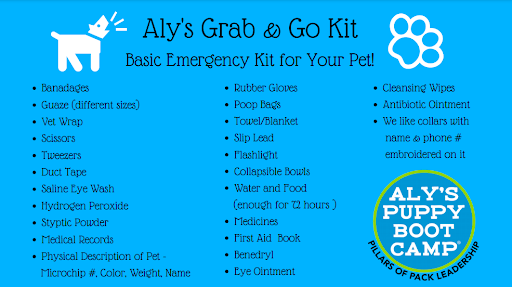Emergency Dog Kit: Tips for Creating a Pet Disaster Kit
An ounce of prevention is worth a pound of cure. If you don't have an emergency pet kit and plan and don't know where to start, keep reading!
In this post, I am going to share what I have in a Grab-n-Go Emergency Dog Kit. I grab it in case we need to leave in a hurry or we need to medically treat an animal.
Here are the essentials in my Basic Emergency Dog Kit:

- Before you trim your dogs nails and accidentally hit an explosion of blood if you nick the quick
- Before your dog ingests an object that you need to make him throw up
- Before the storm or fire comes and you have to evacuate
You probably have most of these at home already like duct tape and cleansing wipes.
But there are a few must-haves for your medical kit that you may not be so familiar with.
Styptic Powder (for dog nail trims)
Styptic powder is both a clotting agent and an antiseptic that is used when trimming nails and you accidentally hit the quick and a surprising amount of blood errupts! It prevents bleeding by contracting the blood vessels that were nipped.
Benadryl (dogs have allergies too)
Children’s Benadryl pills or tablets can be used safely. Never hesitate to ask your veterinarian for the appropriate dosage.
- Hives
- Swelling and inflammation
- Redness
- Runny nose and eyes
- Coughing
- Sneezing
- Anaphylactic reaction
Benadryl for dogs general Dosage guidelines:
| Dog’s Bodyweight | Children’s Benadryl Dosage | Benadryl tablet Dosage | Feeding Schedule | Time Gape |
| 1 – 10 lbs | 0.4 – 4 ml | 1 -10mg | 2 times per day | 8-12 hours |
| 10 – 20 lbs | 4 – 8 ml | 10- 20mg | 2 times per day | 8-12 hours |
| 20 – 30 lbs | 8 – 12 ml | 20-30mg | 2 times per day | 8-12 hours |
| 30 – 40 lbs | 12 – 16 ml | 30-40mg | 2 times per day | 8-12 hours |
| 40 – 50 lbs | 16 – 20 ml | 40-50mg | 2-3 times per day | 8-12 hours |
| 50 – 60 lbs | 20 – 24 ml | 50-60mg | 2-3 times per day | 8-12 hours |
Hydrogen Peroxide (to sterilize or to make your dog vomit)
The AKC guidelines state:
Steps to Take to Make a Dog Throw Up with Hydrogen Perodixe
First, always call your veterinarian. Even if you plan on making your dog throw up at home, your veterinarian is a valuable resource and will be able to provide you with the most accurate information about your dog’s condition.
- If your dog hasn’t eaten within the last two hours, giving him a small meal can make it more likely that he will vomit.
- Make sure you have a 3-percent hydrogen peroxide solution. Higher concentrations are toxic and can cause serious damage.
- Administer the proper amount: the suggested dosage is 1 teaspoon per 5 pounds of the dog’s body weight by mouth, with a maximum dose of 3 tablespoons for dogs who weigh more than 45 pounds. But ask your veterinarian about the best dosage for your dog and only induce vomiting if your dog ate the substance within 2 hours.
- Administer the dosage with a feeding syringe or turkey baster and squirt it from the side by pulling back his lips and squirting between his back teeth. You can also squirt from the front into the back of your dog’s tongue or mouth. Be careful not to let your dog inhale the substance, as this can lead to aspiration. If your dog doesn’t vomit within 15 minutes, you can give him a second dose.
- Stay with your dog while he vomits. Collect the vomit for your vet to analyze, and do not let your dog re-ingest the material.
- Keep an eye out for complications and adverse reactions, such as vomiting for more than 45 minutes, diarrhea, lethargy, bloat or gastric dilatation-volvulus (GDV), or gastric ulcers.
- Follow up with your veterinarian as soon as possible.
Timing is critical, and the safest step is to take your dog to the veterinary office or emergency clinic to have vomiting induced. In some cases, other treatment may also be needed, such as IV fluids. And if you haven’t been successful making your dog vomit, your vet may give him a stronger medication to get rid of the substance he swallowed, as well as the hydrogen peroxide.
There are times when you should NOT induce vomiting. If your dog is having convulsions, is in shock, depressed, unconscious or has difficulty breathing. Do not induce vomiting when the dog has swallowed something sharp or in instances where the directions for usage state that vomiting should not be induced if swallowed.
In addition to these, anything that may cut or bruise the dog as well as cause them tissue damage should not be forced up. Where you are not certain what item was ingested, it is best not to try inducing vomiting but instead contact the nearest poison control office for animals.
Remember, induction of vomiting should be done within two hours of when your dog ate something they shouldn't have.
Past this time, the dog will have digested the toxin and inducing vomiting may not be of much help.
You never know what is going to happen, so it is best to get prepared.
Be ready before the pet emergency happens, having a kit filled with emergency pet supplies could end up saving your dogs life!



